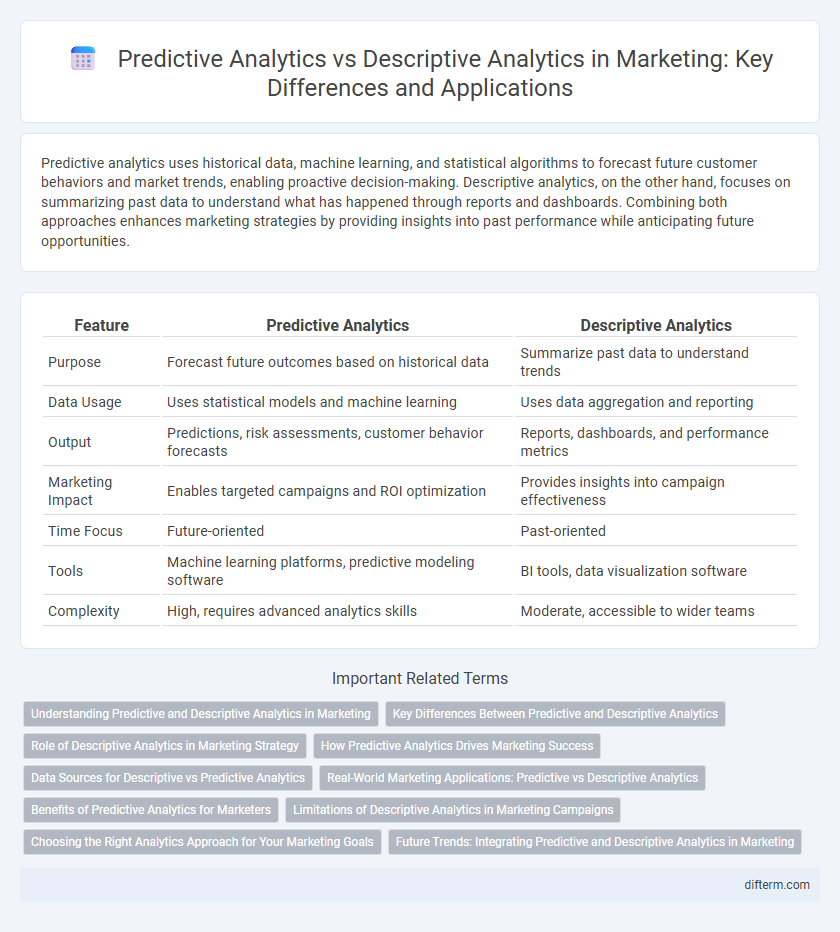Predictive analytics uses historical data, machine learning, and statistical algorithms to forecast future customer behaviors and market trends, enabling proactive decision-making. Descriptive analytics, on the other hand, focuses on summarizing past data to understand what has happened through reports and dashboards. Combining both approaches enhances marketing strategies by providing insights into past performance while anticipating future opportunities.
Table of Comparison
| Feature | Predictive Analytics | Descriptive Analytics |
|---|---|---|
| Purpose | Forecast future outcomes based on historical data | Summarize past data to understand trends |
| Data Usage | Uses statistical models and machine learning | Uses data aggregation and reporting |
| Output | Predictions, risk assessments, customer behavior forecasts | Reports, dashboards, and performance metrics |
| Marketing Impact | Enables targeted campaigns and ROI optimization | Provides insights into campaign effectiveness |
| Time Focus | Future-oriented | Past-oriented |
| Tools | Machine learning platforms, predictive modeling software | BI tools, data visualization software |
| Complexity | High, requires advanced analytics skills | Moderate, accessible to wider teams |
Understanding Predictive and Descriptive Analytics in Marketing
Predictive analytics in marketing uses historical data and machine learning models to forecast customer behavior, enabling targeted campaigns and improved ROI. Descriptive analytics focuses on analyzing past marketing performance to understand trends and customer preferences, providing actionable insights for optimizing strategies. Integrating both approaches enhances decision-making by combining the power of future predictions with a clear understanding of past outcomes.
Key Differences Between Predictive and Descriptive Analytics
Predictive analytics uses historical data, machine learning algorithms, and statistical models to forecast future trends and customer behaviors, enabling proactive decision-making. Descriptive analytics focuses on summarizing past data through reports and dashboards to understand what happened and identify patterns or anomalies. The key difference lies in predictive analytics' forward-looking approach compared to descriptive analytics' retrospective analysis for insight generation.
Role of Descriptive Analytics in Marketing Strategy
Descriptive analytics plays a crucial role in marketing strategy by analyzing historical data to identify customer behaviors, preferences, and campaign performance. It enables marketers to segment audiences effectively, track key performance indicators (KPIs), and optimize resource allocation based on past trends. This data-driven insight forms the foundation for informed decision-making and future strategy development.
How Predictive Analytics Drives Marketing Success
Predictive analytics leverages historical data and machine learning algorithms to forecast customer behaviors and market trends, enabling marketers to tailor campaigns with precision and optimize budget allocation. Unlike descriptive analytics, which summarizes past performance, predictive models identify patterns that anticipate future opportunities and risks, driving proactive decision-making in customer segmentation and personalized targeting. This data-driven foresight enhances customer acquisition, retention rates, and overall marketing ROI by focusing efforts on high-value prospects and timely engagement strategies.
Data Sources for Descriptive vs Predictive Analytics
Descriptive analytics relies primarily on historical internal data sources such as sales records, website traffic logs, and customer transaction history to summarize past performance and identify trends. Predictive analytics combines these internal datasets with external data sources like social media behavior, market trends, and demographic information to forecast future outcomes and customer actions. The integration of diverse, real-time data streams enhances the accuracy and relevance of predictive models compared to the static nature of descriptive data analysis.
Real-World Marketing Applications: Predictive vs Descriptive Analytics
Predictive analytics in marketing leverages historical data and machine learning algorithms to forecast future customer behaviors, enabling targeted campaigns and personalized offers that increase conversion rates. Descriptive analytics focuses on analyzing past marketing performance metrics such as sales figures, customer engagement, and channel effectiveness to provide insights for optimizing current strategies. Real-world applications include using predictive models for lead scoring and churn prediction, while descriptive analytics supports campaign reporting and customer segmentation analysis.
Benefits of Predictive Analytics for Marketers
Predictive analytics enables marketers to anticipate customer behaviors and preferences by analyzing historical data, leading to more targeted campaigns and higher conversion rates. It enhances decision-making by forecasting market trends and customer lifetime value, optimizing resource allocation for maximum ROI. This approach also helps in identifying potential risks and opportunities, allowing proactive strategies that improve customer retention and acquisition.
Limitations of Descriptive Analytics in Marketing Campaigns
Descriptive analytics in marketing campaigns primarily focuses on historical data, providing insights into past customer behavior but lacks the ability to forecast future trends or customer actions. This limitation restricts marketers from proactively optimizing campaigns or anticipating market shifts, which predictive analytics addresses by employing statistical models and machine learning algorithms. Without predictive capabilities, relying solely on descriptive analytics can lead to reactive decision-making and missed opportunities for personalized targeting and improved campaign ROI.
Choosing the Right Analytics Approach for Your Marketing Goals
Predictive analytics leverages historical data and machine learning algorithms to forecast future customer behaviors, enabling marketers to anticipate trends and personalize campaigns effectively. Descriptive analytics focuses on summarizing past performance through data visualization and key metrics analysis, helping identify what happened and why. Selecting the appropriate analytics approach depends on your marketing goals: use descriptive analytics to understand past campaign outcomes and predictive analytics to optimize future strategies and drive proactive decision-making.
Future Trends: Integrating Predictive and Descriptive Analytics in Marketing
Predictive analytics in marketing leverages historical data and machine learning to forecast customer behavior, enabling personalized campaigns and optimized resource allocation. Descriptive analytics provides insights into past marketing performance by analyzing trends and patterns, forming a foundation for data-driven decision-making. The future trend in marketing emphasizes integrating predictive and descriptive analytics to create a seamless feedback loop, enhancing campaign accuracy and driving real-time strategy adjustments.
predictive analytics vs descriptive analytics Infographic

 difterm.com
difterm.com